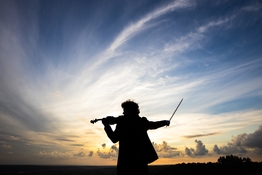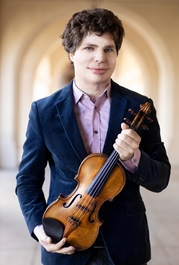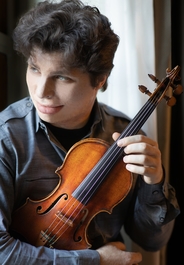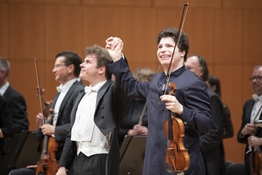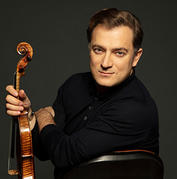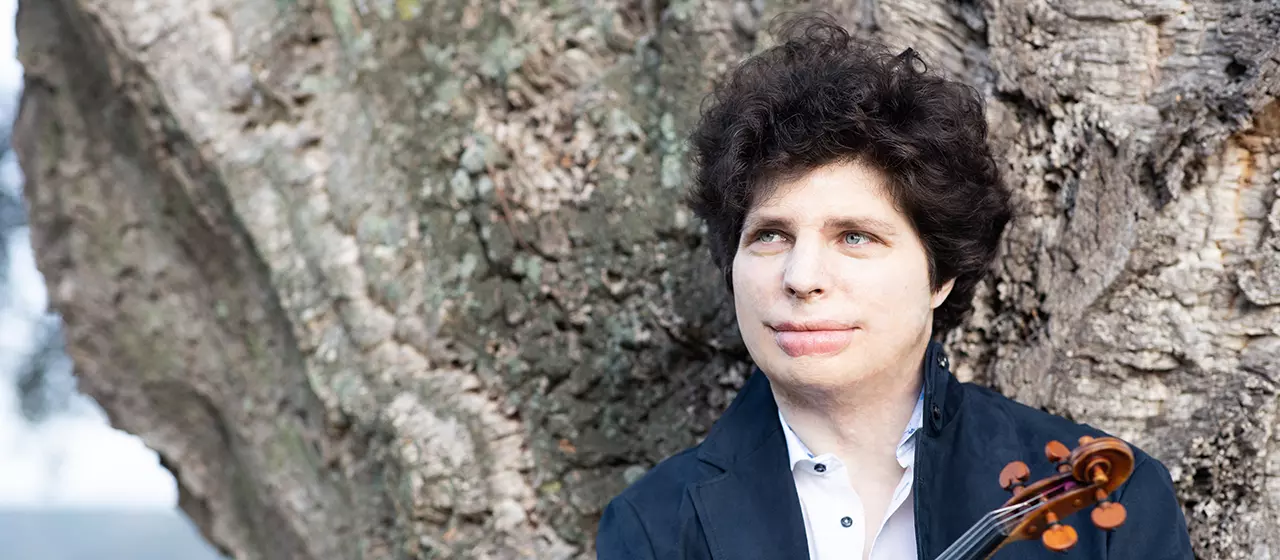

Augustin Hadelich
News
Recuerdos, Augustin Hadelich's newest album announced for August
A subtle and profound Spanish theme runs through Recuerdos – ‘Memories’. Violinist Augustin Hadelich has conceived an album that unites three works for violin and orchestra and a piece originally written for solo guitar. For Britten’s Violin Concerto, Prokofiev’s Violin Concerto No 2 and Sarasate’s Carmen Fantasy he is joined by the WDR Sinfonieorchester and its Chief Conductor, Cristian Măcelaru; he remains alone for Ruggero Ricci’s arrangement of Tárrega’s shimmering Recuerdos de la Alhambra.
Hadelich, whose 2021 Warner Classics release of Bach’s Solo Sonatas and Partitas brought him his fourth nomination for a Grammy Award, explains more about the album:
“Programmes can tell a story — the way different musical works follow each other greatly affects the impact on the listener; and it can sometimes reveal unexpected, even refreshing connections … For years, I’ve been thinking about how to tell the story of the Britten violin concerto, a deeply emotional work written as a reaction to the horrific Spanish Civil War of 1936-39 … Britten was just 23 years old in 1938, when he wrote this concerto for the Spanish violinist Antonio Brosa. Even years later, he felt that it was one of his greatest creations … Although the work is not overtly programmatic, it can be seen as Britten’s expression of his anguish about the conflict and his search to find hope again. It is perhaps the most technically difficult of all the concertos written before 1950, but there is also tender and passionate lyricism, which is typical of much of Britten’s writing.
“The album opens with an earlier view of Spain: Carmen Fantasy, Pablo de Sarasate’s arrangement of themes from Georges Bizet’s famous opera. [The Fantasy was written in 1882, seven years after the premiere of Carmen at Paris’s Opéra-Comique] … Sarasate selected five musical episodes from the opera, and despite the rich embellishment, his arrangement stays remarkably close to Bizet’s original. A violinist of great elegance and refinement, Sarasate knew how to toss off the hardest technical fireworks and show off his skills, while keeping his focus on bringing the characters and emotion of these opera scenes to life.
“I purposely chose Prokofiev’s second concerto, partially written in Spain, to directly precede the Britten concerto – Prokofiev’s expressionist style was a major inspiration for Britten. The use of castanets in Prokofiev's last movement connects to the rhythms of both Bizet and Britten. Prokofiev wrote the concerto in 1935, while he was touring with the French violinist Robert Soutens. Different parts of the concerto were actually written in different cities all over Europe, including in Spain, where the work was premiered [in Madrid]. Prokofiev seems to have been fairly naïve about politics, and therefore had little inkling of the brutal civil war that was to break out in Spain only seven months after the premiere.
“The programme concludes with Recuerdos de la Alhambra, Tárrega’s sadly beautiful guitar meditation [written in 1899]. To imitate its ‘tremolo’ guitar technique, Ruggero Ricci’s arrangement for solo violin uses a jumping ‘ricochet’ bow technique ... When heard after the Britten concerto, Recuerdos de la Alhambra feels like a poignant meditation on loss. One does not need ever to have seen the Alhambra castle, or to be a scholar of the Spanish Civil War to understand this – one needs only to be human and sensitive to the suffering surrounding us in this world.”
Augustin Hadelich announces his sensational fourth album with Warner Classics
“Recording Bach’s complete Six Sonatas and Partitas has long been a dream of mine,” says Augustin Hadelich. “In March 2020, the music world came to a standstill. The lockdown period, with its difficult emotions and feelings of uncertainty, was the perfect time to delve into Bach’s masterpieces and to undertake the enormous project of recording the whole set. I hope that this music will give listeners as much as it has given me.”
It was with another, very different landmark of the repertoire for solo violin, Paganini’s dazzling 24 Caprices, that the US-based violinist made his Warner Classics debut in early 2018. Gramophone magazine, recognising his imagination and his capacities for transcending sheer technical challenges, wrote that, “Hadelich plays these pieces not as studies but as tone poems, even rhapsodies,” and recommended his interpretation to an audience eager “to experience this music as music first and foremost”.
Hadelich describes Bach’s Six Sonatas and Partitas as “among the most quintessential works written for the violin. They are formidable tests of technical ability and stamina, but also of musical imagination and expressive range. Like most violinists, I have studied and performed these works all my life, and yet they never cease to provide challenges, hope, and joy …. I first encountered Bach when I was seven, playing the Preludio and Gavotte [from the Partita No. 3 in E major], as well as the G minor Adagio [from the Sonata No 1] ... Bach’s mastery of counterpoint can create the illusion that his music is scholarly and austere – but it is not so. All his music is suffused with emotion and exudes a life-affirming joy. We can hear an extraordinary yet humble human being talking to us through the centuries.”
Hadelich also points out that in the 19th century, and much of the 20th, there was a tendency to see Bach as a solemn composer. “Perhaps because of the wealth of religious music that he left behind, he was often imagined as an austere religious recluse. ‘Bach never smiled,’ teachers would remind their students. When performances and recordings of the Sonatas and Partitas became more common in the 20th century, they reflected the era’s general approach to performing baroque music: heavy, slow, severe. Playing and listening to Bach was hard, but it was good for you. This was how I, too, first learned to play Bach...
“Everything changed with the advent of ‘historically informed’ principles of playing, which took as their starting point the instruments and bows of the baroque era, and which rediscovered the playfulness, lightness and eccentricity of baroque music ... It is of course impossible to know exactly how people played 300 years ago, but period performance practice, based on careful study of texts, manuscripts and instruments of the period, has corrected many misconceptions about baroque music ... It turns out that baroque performance practice was far less conservative and more flamboyant, wild, adventurous than we thought!”
Hadelich explains how he adopted certain historically informed approaches for this recording. “It was a revelation for me to play these works with a baroque bow... It becomes easier to produce buoyant, light articulation, and harder to produce a loud, sustained sound. It felt liberating to play Bach with a baroque bow: I found I could strike the strings with more energy, but without having to worry that the sound might become too rough or expressionistic. Passages of three- and four-note chords felt more fluid. The dance movements danced more and the slow movements sang more. There are stylistic decisions that any player must make when playing Bach and I sometimes let the baroque bow guide me to find the right articulation. As for another often contentious aspect of playing Bach... I do use vibrato, but only as much as I feel contributes to the expression of a piece. And since Bach wrote out most ornamentation, I only add ornaments when I feel they are necessary.”
For Hadelich, as for many music-lovers, the pinnacle of Bach’s Six Sonatas and Partitas is the Ciaccona or Chaconne from the Partita No 2 in D minor. “On top of a descending bassline, repeated 64 times, Bach erects towering structures, creates moments of anguish and sorrow, and leads us to moments of introspection and bliss,” he says. “It feels like a journey through life itself. It is not hyperbolic to say that the Chaconne might be the greatest piece ever written for the violin.”
The words of the Washington Post suggest that Hadelich is the ideal guide for the journey through the Chaconne and, indeed, the entire set of Bach’s Sonatas and Partitas: “The essence of Hadelich’s playing is beauty: reveling in the myriad ways of making a phrase come alive on the violin, delivering the musical message with no technical impediments whatsoever, and thereby revealing something from a plane beyond ours.”
Violinist Augustin Hadelich returns with Bohemian Tales
Taking Dvořák’s richly melodic violin concerto as its centrepiece, Bohemian Tales explores the music of three Czech composers. Violinist Augustin Hadelich is joined for the concerto by Czech conductor Jakub Hrůša and the Symphonieorchester des Bayerischen Rundfunks. In smaller-scale works by Dvořák, Janáček and Josef Suk, Hadelich’s partner is the British pianist Charles Owen.
When these three composers were born (Dvořák in 1841, Janáček in 1854 and Suk in 1874), the Czech lands – known as the Bohemian Kingdom – were part of the Austro-Hungarian Empire. The end of World War I in 1918 saw the emergence of the Czechoslovak Republic. Bohemia itself, where Prague is situated, is one of the three principal regions of the modern-day Czech Republic. The other two are Moravia – Janáček made his home in its capital, Brno – and Czech Silesia.
As Augustin Hadelich explains: “During the second half of the 19th century many non-German composers were taking a special interest in creating their own ‘national’ styles by drawing on the languages, stories, landscapes and folk music of their homelands. Each of these three composers was a unique contributor to the history and scope of Czech classical music.”
Dvořák’s violin concerto, though not a landmark of the repertoire like his epic cello concerto, is a characteristically engaging and warm-hearted work. “When Dvořák wrote it in 1879,” explains Hadelich, “he was certainly influenced by Johannes Brahms, who had written a concerto himself the year before, but the layout of its first two movements more closely follows the blueprint of the first violin concerto by Max Bruch. The passionate first movement starts with free, improvisatory passages for the soloist that establish the protagonist of the story … The lyrical and expansive slow movement forms the heart of the concerto, while the last movement is a spirited furiant dance with a dumka interlude [in other words, contrasting and melancholy]. Throughout the work, Dvořák's characteristic Czech harmonies, lyricism and references to folk music create a soulful depth ... I knew from the first rehearsal with the Bavarian Radio Orchestra and Jakub Hrůša, that I had found the ideal collaborators for this work. During the five years prior to the concerts and recording of this album, Jakub and I performed this piece together a number of times with different orchestras. He is a highly sensitive musician with an intrinsic sense of the rhythms and characters of this music.”
When Hrůša conducted Hadelich in a performance of the concerto with the New York Philharmonic in 2017, the New York Times wrote: “Mr Hadelich increasingly seems to be one of the outstanding violinists of his generation … His lustrous sound and tenderness were ideal for the pensive passages of the slow movement. In the finale … Mr Hadelich and the orchestra conveyed the music’s rousing energy, while somehow maintaining a breezy lilt.” Later the same year, Hadelich performed the Dvořák concerto in Edinburgh. Bachtrack described “a solo line of operatic intensity and Elysian beauty, pouring down lyricism from heights that you seldom associate with this concerto ... sweeping in its intensity but touching in its simplicity.”
The three short works by Dvořák that Hadelich plays with pianist Charles Owen – with whom he has been collaborating for 10 years – are the captivating Humoresque, the touching ‘Songs My Mother Taught Me’, and, in Hadelich’s view, “one of Dvořák's great masterworks”: the last of the composer’s four Romantic Pieces, written eight years after the concerto. “A lamenting figuration is repeated throughout the whole piece, as it goes through different stages of grief … The violin reacts emotionally to the modulations in the piano part, going from sobbing quietly to wailing; from desperation to acceptance; from struggling against grief to quiet resignation.”
Josef Suk is closely connected with Dvořák, who started off as his teacher and became his father-in-law. “His Four Pieces were written in 1900, with the first (‘Quasi Ballada’) being the most modern of the four,” recounts Hadelich. “The instability of the harmony creates a mood of uncertainty, searching for resolution. The second piece (‘Appassionato’) is an energetic folk dance with a lyrical middle section. The third movement (‘Un poco triste’) is a sad folk song with a whimsical middle section … The motif of the middle section forms the basis for the fourth piece (‘Burleska’), which sounds like a high-speed, almost cartoonish chase with many unexpected turns.”
Janáček’s violin sonata was written between 1914 and 1922 – a dramatic period in European history during which Czechoslovakia came into being. It is cast in four compact movements. “The work opens with an impassioned theme in the violin, accompanied by shuddering tremolandi in the piano. The second movement is tender and explores the quietest dynamics during moments of stillness. The third movement features a folkloristic theme in the piano while the violin interrupts with unsettling, gruff scales.
“The final movement depicts the arrival of Russian troops in Moravia, with the violin imitating bursts of machine-gun fire as the piano plays a sorrowful and lyrical theme …The climax has the violin finally playing the main theme with the utmost intensity to shattering high tremolandi in the piano, before the opening returns and the work ends with the gunfire fading into the distance ... Life in Europe was forever changed after the Great War.”
Violinist Augustin Hadelich signs to Warner Classics
Warner Classics has signed an exclusive recording contract with violinist Augustin Hadelich, with his label debut to be released on 12 January 2018. The signing comes as a natural progression for the 33-year-old virtuoso, who was chosen as laureate of the inaugural Warner Music Prize in 2015.
The elegant yet impassioned musicianship of Augustin Hadelich evokes the violinists of the golden age of the early and mid-20th century. It is fitting, then, that his first album on Warner Classics presents the summit of the art and virtuosity of his instrument with Paganini’s 24 Caprices, which he has recorded on the 1723 ‘Ex-Kiesewetter’ Stradivarius violin.
“I am thrilled to make my first recording for Warner Classics,” said Hadelich. “I have dreamed of recording these caprices ever since I first worked on them as a child. Paganini’s music was a major part of my musical upbringing in Italy, and over the years I have often performed his caprices as encores.
“In Paganini’s works, the technical fireworks always serve the music, not the other way around. As he explores different extended techniques and virtuosic acrobatics, he reveals himself to be a thoughtful and inspired composer. Many of the caprices are charming, funny, entertaining and thrilling, some are dramatic and passionate, and yet others serene and lyrical. Each Caprice has its own quirky personality; some are my friends, but others are ferocious beasts to be tamed!”
Jean-Philippe Rolland, Executive Vice-President International A&R and Business Development of Warner Classics & Erato, added: “Augustin’s sound is innately lush, expressive and recognizable. He is a self-reliant yet communicative artist who takes palpable pleasure in performing. These are unique qualities seldom found in a young violinist today, and Augustin has them all. We are delighted to embark on this journey with him.”
ABOUT AUGUSTIN HADELICH
Augustin Hadelich has firmly established himself as one of the great violinists of today. He has performed with every major orchestra in the U.S., many on numerous occasions, as well as an ever-growing number of major orchestras in the UK, Europe, and the Far East. Showcasing a wide-ranging and adventurous repertoire, he is consistently cited for his phenomenal technique, poetic sensitivity, and gorgeous tone.
In Europe he has performed with the Royal Concertgebouw Orchestra, London Philharmonic, Munich Philharmonic, BBC Philharmonic, BBC Symphony, Royal Liverpool Philharmonic, Finnish Radio Symphony, Danish National Symphony, Norwegian Radio, Helsinki Philharmonic, Netherlands Philharmonic, Rotterdam Philharmonic, Orquestra de Cadaqués and the Radio Orchestras of Frankfurt, Saarbrücken, Stuttgart and Cologne. He was Artist-in-Residence with the Bournemouth Symphony Orchestra in the 2015-16 season and made his Proms debut in 2016.
Also an enthusiastic recitalist, Hadelich has performed at prestigious venues including the Wigmore Hall, Carnegie Hall, Kennedy Center in Washington, Amsterdam Concertgebouw, Louvre (Paris), Kioi Hall (Tokyo) and at the Rheingau and Mecklenburg-Vorpommern Festivals.
Born in Italy, the son of German parents, Augustin Hadelich is now an American citizen. He holds an Artist Diploma from The Juilliard School, where he was a student of Joel Smirnoff. His career took off when he was named Gold Medalist of the 2006 International Violin Competition of Indianapolis – an event that has been described as the Olympics of the Violin. He went on to win an Avery Fisher grant in 2009, a Borletti-Buitoni Trust Fellowship in 2011 and a Grammy Award in 2016. He has been named Musical America’s Instrumentalist of the Year for 2018. Augustin Hadelich plays the 1723 ‘Ex-Kiesewetter’ Stradivari violin, on loan from Clement and Karen Arrison through the Stradivari Society of Chicago.
Upcoming Concerts
Monday
Friday
Saturday
Sunday
Wednesday

